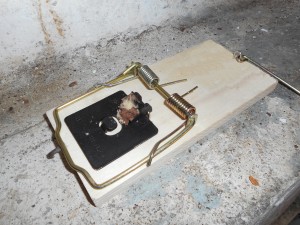When preparing for any job, my dad will remind me to choose the right tool for the task. In a way, this is an extension of another one of his gems: work smarter, not harder. Selecting the right tool can increase your efficiency and help you to get the job done correctly. Time and again I have reaped the benefits of this wisdom.
On a recent inspection of a food service establishment, management informed me that they had seen a small rat in the service hallway. Traps had been placed by the pest professional, but as of yet, the stealthy rat had not been caught. My interest was piqued.

In the hallway I found that several rat snap traps had been baited and placed along the wall where the rat had been observed. One trap had been tripped, and actually had a small piece of the rodent’s tail attached, which seemed rather odd. How would a rat trigger the trap and get only its tail caught? That is when the real detective work started.

No droppings were present along this runway to help with identification, but the now short-tailed rodent had fed on the bait, leaving behind impressions of its teeth. I pulled out my ruler and found that the pair of teeth were less than 2mm wide, which is suggestive of mice. Indeed, mice tend to leave impressions that are 1 to 2mm wide, while a pair of teeth for rats tends to be 3.5 to 4mm wide. Now the pieces of this mystery were adding up. A small rat was not the culprit, but rather a mouse. The traps had not been effective (except for taking off a piece of tail) because mice are unlikely to exert enough force on the trigger to engage a rat trap. So, what is the right tool for this task? You guessed it, a mouse trap!
Did you know…
The term rodent (the group that includes mice, rats and their relatives) is a derivative of the Latin word rodere, which means “to gnaw.” Rodents gnaw on objects to obtain resources, in the process wearing down their teeth. In fact, rat teeth grow approximately 5 inches per year, and are kept short by their gnawing behavior or by grinding their teeth.

For more information, watch our YouTube video: Signs of a Rodent Infestation